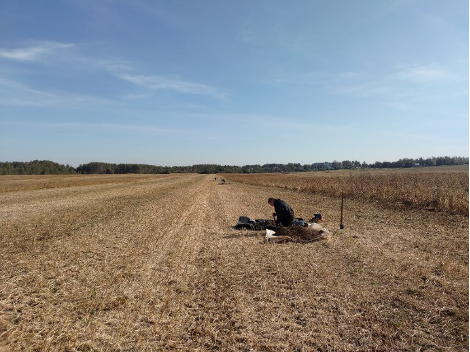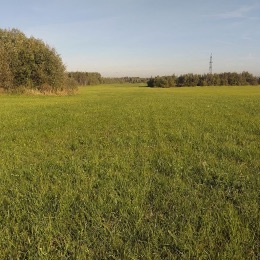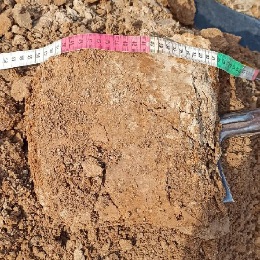Employees of the Federal Research Center V.V. Dokuchaev Soil Science Institute have established a new carbon pools monitoring polygon on sod-podzolic soils of agricultural landscapes in the Sergiev Posad district.
In September 2024, FRC employees began the creation of a test site on the fields of the agricultural production cooperative (APK) "Kuzminsky" in the Sergiev Posad district of the Moscow region. Test polygon belongs to the southern taiga zone of sod-podzolic soils (Fig. 1), on the border of the Smolensk-Moscow moraine upland and the Upper Volga sandy lowland. The enterprise specializes in the production of cattle and raw milk, therefore, in the structure of land use, there are hayfields, fallow lands, and arable land with a large proportion of perennial grasses in crop rotation. Grain and leguminous crops, as well as root crops with a high content of starch or insulin, are grown on arable land.
When setting the test polygon, we used materials from the work on agro-ecological grouping and land assessment carried out in 2020. We inspected 83 fields, set 167 soil pits, and carried out an agrochemical survey. It was determined that sod-podzolic loamy and sandy loam soils predominate, locally there are bog and alluvial soils. It was revealed that the content of soil organic matter (SOC) varies from 0.3% to 12%. The farm practices the application of organic fertilizers (manure) and the cultivation of crops on drained bogs, which contribute to the formation of increased humus reserves. The salt pH ranges from 3.8 to 7.3 units. In some sections, carbonate moraine was exposed, effervescing from 10% HCl.

Fig. 1. Location of the "Kuzminsky" test site (a) and the soil cover pattern of the enterprise with visualization on the geoinformation portal of the Federal Research Center "V.V. Dokuchaev Soil Science Institute" (https://gip.esoil.ru/#, b).
Dynamic plots within the test site are located on arable land occupied at the end of the 2024 season by perennial grasses (Fig. 2, left) and soybean stubble, grown as part of a production experiment with varieties and cultivation technologies of this crop in the difficult conditions of the Non-Black Earth Region (Fig. 2 right).
The creation of the site allows assessing the short-term (up to 2-3 years) impact of perennial grasses in crop rotation on the carbon balance in the soils of agro-ecosystems in different geomorphological conditions, as well as comparing carbon stocks in soils with different cultivation histories.
Fig. 2. Agricultural landscapes of APK "Kuzminsky". Left - a field with perennial grasses, right - soil sampling of the field on a harvested "strip" of soybeans.
During the survey of the enterprise's land use, a significant heterogeneity of the microrelief and soil cover was revealed, caused by paleocryogenic processes of solifluction, cryoplanation, and thermokarst. On satellite and UAV images, the open soil surface is very contrasting (Fig. 3). Convex "light spots" are occupied by sod-podzolic gleyic soils (Fig. 4A), and concave accumulative positions of "dark stripes" are occupied by sod-podzolic gley soils, as well as sod-podzolic gley and gleyic soils with a second humus horizon (Fig. 4B).

Fig. 3. Satellite image with the location of soil survey points taken as part of the survey against the background of a satellite image (A) and an example of cryogenic spottiness on a UAV image (B).
More than 10 performers from the departments of Agro-ecological Assessment of Soils; Physics, Hydrology and Soil Erosion; Genesis and Reclamation of Saline and Solonetzic Soils, as well as the laboratory of Digital Twins of Agricultural Landscapes of FRC, participated in the work on the test site creation. 5 one-day trips were made on September 24, 26, October 2, 10, and 11, 2024, during which the employees conducted a detailed soil survey of 3 fields and set test monitoring plots on contrasting soils typical for this region. In total, there are 4 monitoring plots at the polygon: 2 on sod-podzolic gleyic soils (Fig. 4A), which occupy the areas of "light" spots on the satellite image, and 2 sites on the "dark" areas of the image, one of which is on sod-podzolic gleyic soil with a second humus horizon (Fig. 4B), and the other is on sod-podzolic gley soil (Fig. 4C).

Fig. 4. A – Sod-podzolic slightly gleyic soil, B – Sod-podzolic gleyic soil with a second humus horizon, C – Sod-podzolic gley soil.
The employees of the Federal Research Center sincerely thank the chairman of the APK «Kuzminsky» Khakhunov Oleg Vladimirovich for his assistance in conducting field work.
By 2030, the Federal Research Center V.V. Dokuchaev Soil Science Institute will increase the number of test sites for monitoring carbon pools in agro-ecosystems to 50.
The employees of the Federal Research Center V.V. Dokuchaev Soil Science Institute are participants in the Soil Group of the "RITM of Carbon" consortium in the work on the project "Russian Climate Monitoring System" (a key innovative project of national importance, KIP NI, overseen by the Ministry of Economic Development of the Russian Federation).









